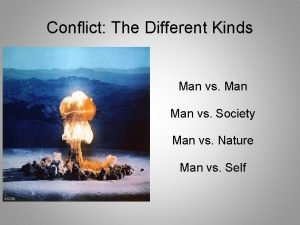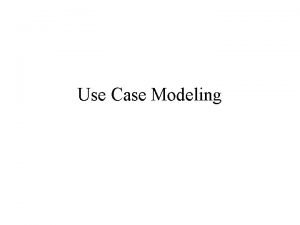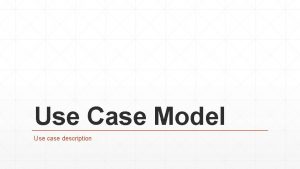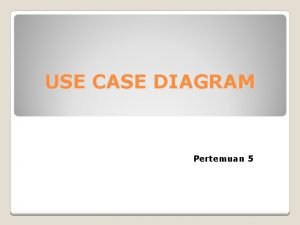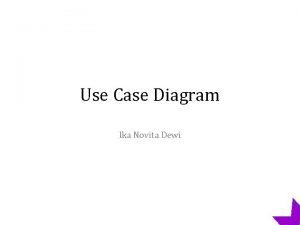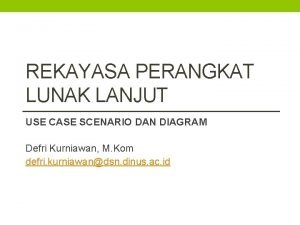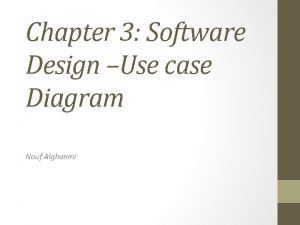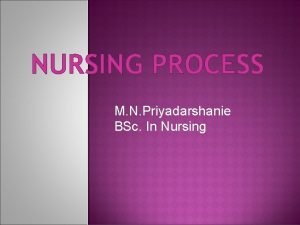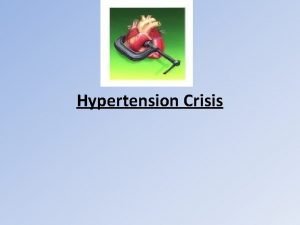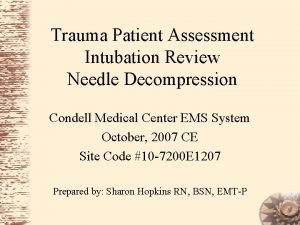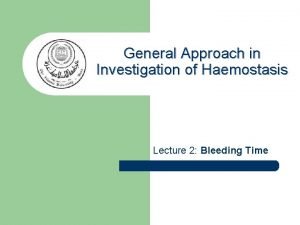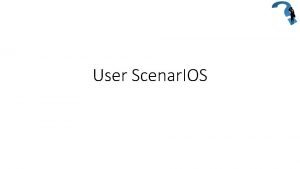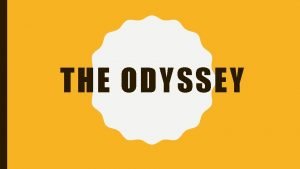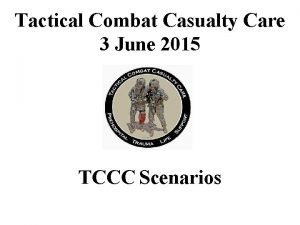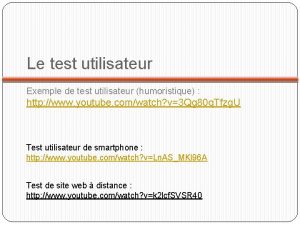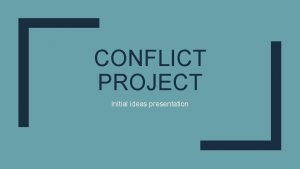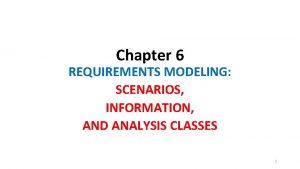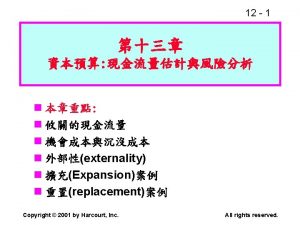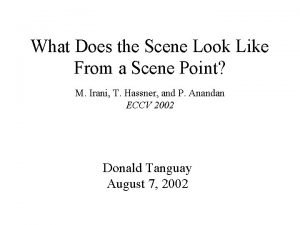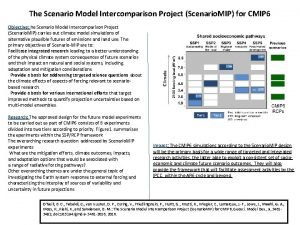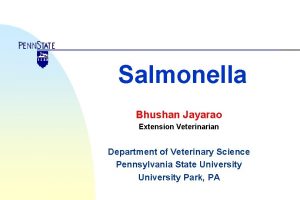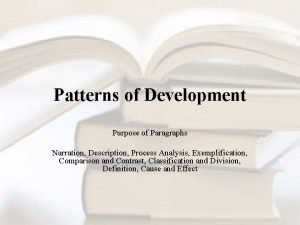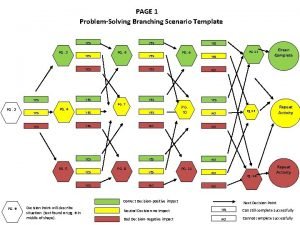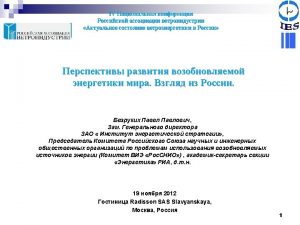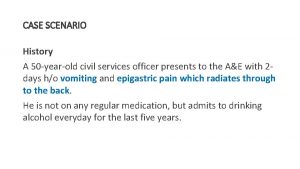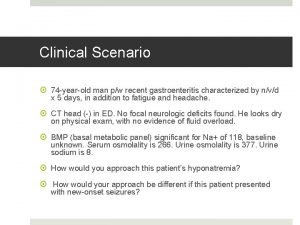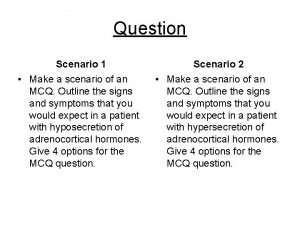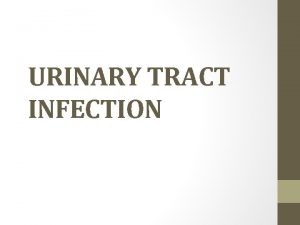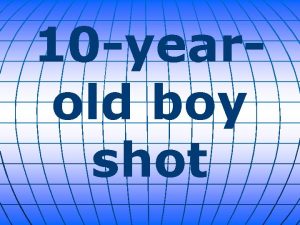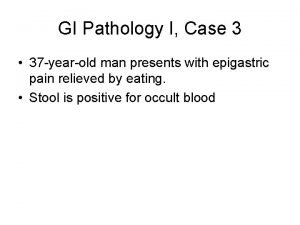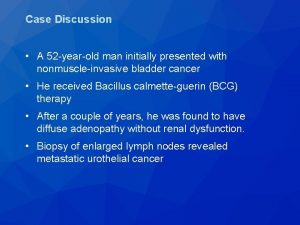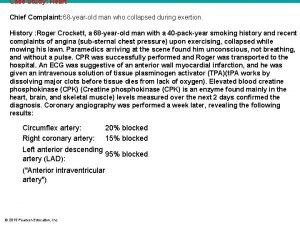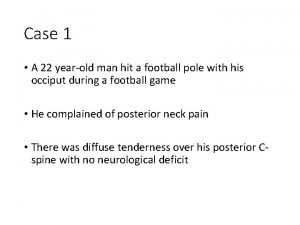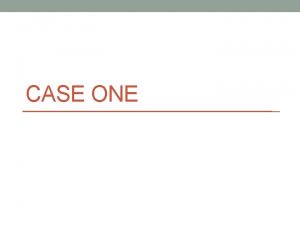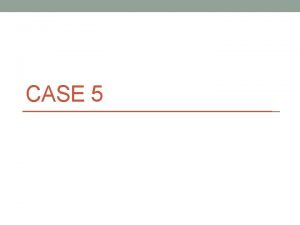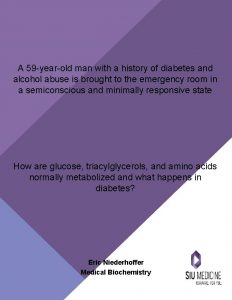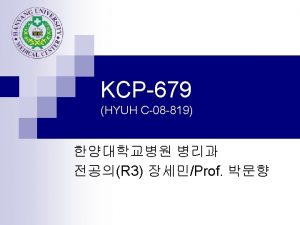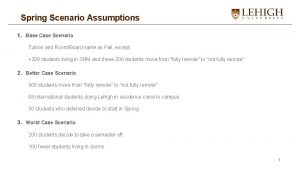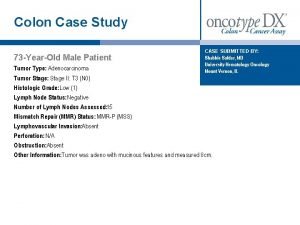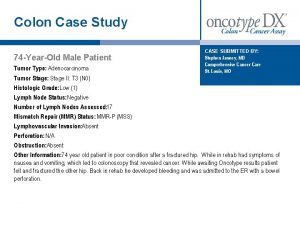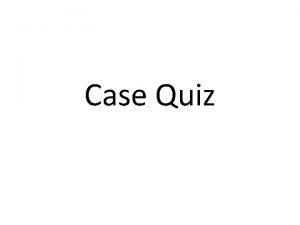Case Scenario History A 73 yearold man with



































- Slides: 35

Case Scenario -History A 73 -year-old man with 3 -months H/O progressively deepening yellow discoloration of skin. He has also noticed that his urine has darkened and his stools have become pale and difficult to flush. His appetite has reduced significantly and he has found that his clothes have become loose.

Case Scenario -Examination Patient appears underweight with yellow discoloration of the skin and sclera. The abdomen is soft with a smooth mass present in the right upper quadrant, which moves with respiration.

Case Scenario § § § What is the most likely diagnosis? What is the underlying cause? Why is stool pale? What is Courvoisier’s law? What further investigations are needed in this patient?

Causes, Investigations & Management of Obstructive Jaundice Faisal Ghani Siddiqui MBBS; FCPS (General Surgery); PGDIP-BIOETHICS; MCPS-HPE; FICLS; (MHPE) Professor & Chairman, Department of Surgery, & Director, Directorate of Medical Education Liaquat University Of Medical & Health Sciences Jamshoro

Learning Objectives At the end of the presentation, the students will be able to: § Define obstructive jaundice § Enlist causes of obstructive jaundice § Identify clinical features of obstructive jaundice § Order and interpret investigations § Outline a management plan

Learning Objectives At the end of the presentation, the students will be able to: § Define obstructive jaundice § Enlist causes of obstructive jaundice § Identify clinical features of obstructive jaundice § Order and interpret investigations § Outline a management plan

Bilirubin from haem Bound to albumin; taken up by hepatocyrtes Conjugated to bilirubin glucuronide

Normal serum level of bilirubin is 17 micromoles/L

Jaundice is a syndrome which is recognized clinically when serum bilirubin exceeds > 40 micromoles/L

Unconjugated bilirubin Hyperbilirubinemia Hemolysis Intrinsic liver diseases (cirrhosis) Gilbert syndrome Conjugated bilirubin Intra-hepatic cholestasis Extra-hepatic cholestasis

Obstructive Jaundice -Definition Jaundice due to partial or complete obstruction to the flow of bile into the GIT

Intra-hepatic cholestasis Failure to secrete conjugated bilirubin into the hepatic canaliculi Obstructive Jaundice Extra-hepatic cholestasis Obstruction in extrahepatic biliary duct

Intra-hepatic cholestasis Drugs Obstructive Jaundice Antibiotics Antithyroid drugs Hypoglycaemics Anticancer drugs Corticosteroids Anti-inflammatory drugs Anticonvulsants Anaesthetic agents Psychiatric drugs Cardiovascular drugs Rotor syndrome Dubin-Johnson

Extra-hepatic cholestasis Obstructive Jaundice CBD stones Benign strictures Chronic pancreatitis Parasites (ascariasis; clonorchisis) Choledochal cyst Periampullary carcinomas

Carcinomas Causing Obstructive Jaundice

Learning Objectives At the end of the presentation, the students will be able to: § Define obstructive jaundice § Enlist causes of Obstructive jaundice § Identify clinical features of obstructive jaundice § Order and interpret investigations § Outline a management plan

Obstructive Jaundice Clinical features § § § Jaundice Dark urine Clay-colored stools Itching Pain Weight loss; anorexia

Learning Objectives At the end of the presentation, the students will be able to: § Define obstructive jaundice § Enlist causes of Obstructive jaundice § Identify clinical features of obstructive jaundice § Order and interpret investigations § Outline a management plan

LFTs Ultrasound Other Investigations

LFTs Raised direct bilirubin, alkaline phosphatase and gamma-GT Minimal or no elevation of serum transaminases Ultrasound Other Investigations

Case Scenario -Investigations Bilirubin G-GT Aspartate transaminase (AST) Alkaline phosphatase (ALP) 82 mmol/L (↑) 163 IU/L (↑) 66 IU/L 229 IU/L (↑) 3 -17 mmol/L 11 -51 U/L 5 -35 IU/L 35 -110 IU/L

LFTs Ultrasound Dilated biliary tract Other Investigations

Role of Ultrasound in Obstructive Jaundice Ultrasonographic detection of dilated biliary tract is the first step in the investigation of patients with biochemical evidence of obstructive jaundice

Role of Ultrasound in Obstructive Jaundice § Ultrasound does not provide information on the cause and site of the lesion causing obstruction § Further investigations with CT, MRCP or ERCP is required

LFTs Ultrasound Other Investigations EUS ERCP MRCP CT / MRI

Obstructive Jaundice ERCP § Defines cause of obstruction § Therapeutic • Sphincterotomy / stone removal • Balloon dilatation of strictures • Stenting of strictures

ERCP -multiple stones in common bile duct

ERCP -malignant stricture at lower end of CBD

Obstructive Jaundice -CT Scan § Useful when the outcome of ultrasound/ERCP equivocal § Guided biopsy of tumours § Tumour staging

LFTs Ultrasound Other Investigations

Learning Objectives At the end of the presentation, the students will be able to: § Define obstructive jaundice § Enlist causes of Obstructive jaundice § Identify clinical features of obstructive jaundice § Order and interpret investigations § Outline a management plan

Management of Patient with Obstructive Jaundice Preoperative Management Prevention of infection Correction of coagulation disorders Prevention of renal failure Prevention of hepatic encephalopathy Treat the cause

. . . In summary § § § Definition of obstructive jaundice Causes of Obstructive jaundice Clinical features of obstructive jaundice Investigations in obstructive jaundice Management

Case Scenario § 73 -year-old man with 3 -months H/O progressively deepening yellow discoloration of skin, dark urine and pale stools, difficult to flush. Appetite is reduced and his clothes have become loose § Underweight with yellow discoloration of skin / sclera. Smooth mass in RUQ, moves with respiration

Case Scenario § § § What is the most likely diagnosis? What is the underlying cause? Why is stool pale? What is Courvoisier’s law? What further investigations are needed in this patient?
 Conflict vs society
Conflict vs society Case scenario examples
Case scenario examples Use-case model
Use-case model Contoh use case
Contoh use case Contoh use case scenario
Contoh use case scenario Contoh use case skenario
Contoh use case skenario Use case scenario example
Use case scenario example Nursing care plan case scenario
Nursing care plan case scenario Case scenario for hypertension
Case scenario for hypertension Waste case scenario
Waste case scenario Tension pneumothorax case scenario
Tension pneumothorax case scenario Surgicutt method
Surgicutt method Best case worst case average case
Best case worst case average case Piecewise function real life situation
Piecewise function real life situation Scenario in a sentence
Scenario in a sentence User scenario example
User scenario example Scenario summary report excel
Scenario summary report excel Describe the scenario that led prince paris to kidnap helen
Describe the scenario that led prince paris to kidnap helen 9 line medevac example
9 line medevac example Tccc scenario cards
Tccc scenario cards Scenario based learning software
Scenario based learning software Mystery parcs
Mystery parcs Scénario utilisateur exemple
Scénario utilisateur exemple Cyber bullying scenarios
Cyber bullying scenarios Initial idea 1
Initial idea 1 Scenario based modeling in software engineering
Scenario based modeling in software engineering Scenario planning workforce planning
Scenario planning workforce planning Scenario analysis中文
Scenario analysis中文 Homography
Homography Scenario mip
Scenario mip Create a scenario summary report
Create a scenario summary report Typical scenario
Typical scenario Description
Description Branching scenario template
Branching scenario template 450 scenario
450 scenario Critical fuel scenario
Critical fuel scenario
